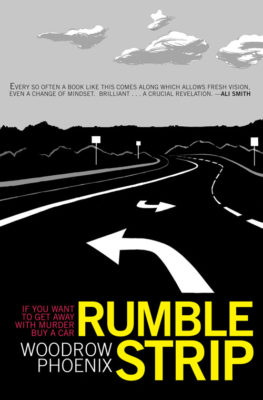Do you drive a car? Please read this book.
A heart-felt, eloquent and surprisingly gripping indictment of our current obsession with cars, our behaviour on the roads and the vulnerability of the pedestrian, this is as Paul Gravett observes, "an extraordinarily human book... without showing a single human being."
I'd hazard a guess that this very exclusion forms part of Woodrow's argument that pedestrians have been relegated to anonymous and dehumanised second-class citizens whose rights are as nothing compared to those of us enclosed in thousands of pounds worth of hard, heavy metal. We're what counts: we need to get where we going far more urgently than you lot on foot, so don't you dare cross the road until you're told to, where you're told to, and I don't give a shit if it's raining outside because it's not raining in here. Where's that CD I burned last night?
Yes, that's how old this review is, resurrected with tweaks for a timely brand-new edition with an infinitely more apposite title, CRASH COURSE: IF YOU WANT TO GET AWAY WITH MURDER, BUY A CAR.
I originally read this an hour before my own car was due in for its annual MOT and service, plus as a precautionary measure they changed what I believe is called the cambelt. If they hadn't, they would definitely be changing it now. I've never understood a mate who was so concerned for his children on board that he turned on his headlights in broad daylight, yet happily answered his mobile phone whilst driving along, one-handed, distracted. For my own guilty part I've lit so many cigarettes over the years while driving. Yup, the first one to put his hand up is me. I'll never do it again, and nor will you once you've read this. I feel wretched.
As Woodrow navigates motorways, turns at junctions and admires the view through his windscreen he muses on our self-delusion when it comes to safety, our attitude to death by driving (you kill someone any other way, and you're in deep trouble; in a car, not necessarily so much), the horrors of the pedestrian underpass, the weirdness of an empty retail car park, and the absurd SUV 4x4 family arms race. It's moving, compelling and even poetic in places, pared down to level-headed wake-up calls like this:
"There is a dreamlike quality built into the experience of driving. A car windshield is a big window. And also a screen. A windscreen. A long rectangular picture frame. Locations unwind on the other side of this rectangular glass almost as they do on a movie screen. The constant, smoothly unrolling scenery. The continuously changing vistas. It's like the ultimate cinematic presentation. With you, the driver, as both the director and the star."
It can be mesmerising too.
"It's an intoxicating feeling to have the power to govern every aspect of your private world. You sit cocooned in your cabin. You control the temperature of the interior and you listen only to the soundtrack you have chosen. Everything outside your windows is contained, the rest of the world an arm's length away."
But no more than that for BMW drivers who tailgate.
That's from about the least affecting couple of pages of this book (and they ring so true, don't they?) as Phoenix assesses what your car says about you, why some arrogant arseholes refuse to budge out of the middle or even outside lane regardless of what speed they're doing (my own biggest irritation with others, along with their failure to indicate - the consequences of which you'll discover towards the end), and quietly relates some very real incidents of fatal failures to give a damn about cyclists and those on foot.
As to road rage:
"How did it happen that ridiculous, inappropriate eruptions of impulsive brutish aggression should have been thought to be adequately described by the handy appellation, 'road rage'? It's a phrase that hides more than it reveals. Designed to neuter and tidy away the truth. A sheet thrown over a misshapen lumpy ogre of violence. Almost legitimising the strange shapes that poke around underneath. Road rage is an indulgent, doting term, dignifying and excusing behaviour that has no dignity and no excuse."
And so we come to the art. Roads. Roads and roads of roads. And rorries.
Is it even necessary? Would your experience reading this be any different if you'd just paid £1-50 for this week's Guardian, and this was reduced to a single prose feature in the Weekend Supplement rather than 150 pages of chevrons? Yes. Yes it would, because the chevrons here are as hypnotic as they are in real life, and therein lies a point.
Anyway it's not all roads: there is, for example, a small procession of human beings reduced from individuals to the faceless figurative forms that symbolise human beings on pedestrian crossings; and you'll never take those for granted again, either. Best not think of all those actual lives now snuffed out: people who woke up and went for a walk but will never come home again.
The ideas I've expressed here are all Woodrow's - ideas, not views: his views if not awful experience match my own seamlessly. I could never have done so without his prompting, and it worries me terribly that I may ever be careless enough to hit someone in my car. The chances of that after reading this, however, are at least a lot slimmer because I've been given a wake-up call, and we could all use a little reminding, surely?
Originally released as RUMBLE STRIP in 2008 (still in stock), this comes with a new essay by Woodrow Phoenix who also notes: "CRASH COURSE is 206pp to RUMBLE STRIP's 160pp with 106 of those pages being completely new US-specific material - and much of what remains tweaked/updated." Why not buy both, then compare and contrast? ;)






